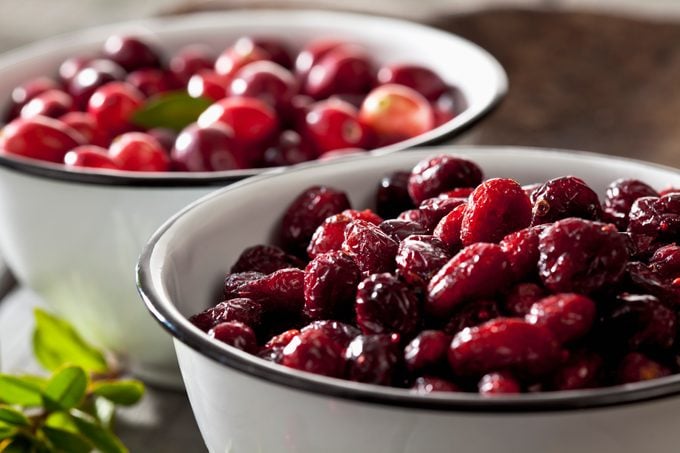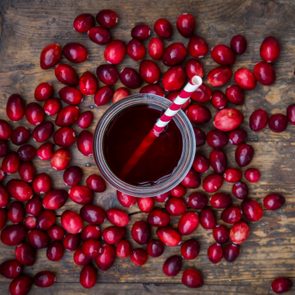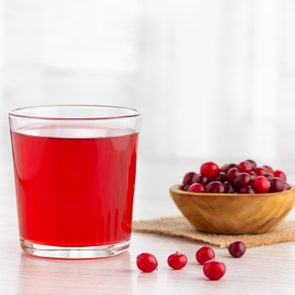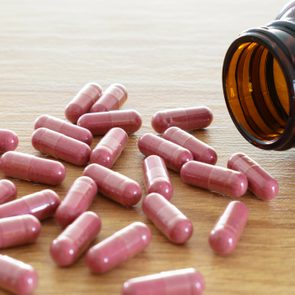Are Dried Cranberries Good for You?
Updated: Mar. 18, 2021
Dried cranberries are a popular fruit in many fall recipes, but they are a delicious way to enjoy cranberries at any time of the year. Here's what you need to know about the nutrition and health benefits of dried cranberries.
Dried cranberries
If you like to eat cranberries, you’re not alone. Americans eat 400 million pounds of cranberries each year, with 20 percent of that consumed during Thanksgiving week, frequently in the form of cranberry sauce.
At other times of the year, the red berry might not be on your radar, unless you’re using cranberry juice as a mixer or to help a urinary tract infection (UTI). Or maybe you happen upon a couple cranberries occasionally in your bag of trail mix.
“One of the reasons that cranberries are overlooked throughout the year is because we so strongly associate them with the holidays,” says Anna Binder-McAsey, RD and owner of Rethink Nutrition in Manhattan, Kansas. They’re in season from September through November, which is why you might see bagged fresh versions in stores now, she adds. But, thanks to dried versions, they can become a year-round sweet treat in your diet.
But, are dried cranberries good for you? Or, are they just sugar bombs in disguise?
Here’s everything you need to know about dried cranberries, including nutrition facts, benefits, risks, and how to eat them.
How are dried cranberries made?
Cranberries grow in bogs or wetlands. After harvest, the fruits are frozen (this preserves their nutrition and breaks down their flesh), then sliced, sweetened, and dried, according to The Cranberry Institute.
You can easily find dried cranberries packaged in store shelves at the grocery (look for them in the aisle near raisins or nuts) or in bulk bins.
If you have fresh cranberries, you can also make these at home using a low heat oven or in a dehydrator, and there are many recipes easily searchable, like this dried cranberries recipe from Massachusetts Cranberries, which offers both a dehydrator and oven drying method.
Dried cranberries nutrition facts
Dried cranberries are packed with the same nutrients found in fresh cranberries. They’re a rich source of various vitamins and minerals, especially fiber and other nutrients. A 1/4 cup (40 grams) of dried sweetened cranberries contains:
Calories: 123
Fiber: 2 g (8% DV)
Carbs: 33 g
Sugars: 29 g
Vitamin C: 0.08 mg
Compared to fresh cranberries, dried cranberries are more concentrated in calories, says McAsey-Binder. That’s why you may want to pay attention to your portions. “This is only something to think about if you’re eating large amounts,” she adds. A quarter- to one-third cup serving is a good place to start.

Health benefits of dried cranberries
Rich in antioxidants
When food is a beautiful natural color, you know it’s nutrient-rich. Dried cranberries contain plant nutrients called polyphenols, Binder-McAsey says.
“Polyphenols in cranberries offer benefits for your heart, urinary tract health, and cancer prevention,” she says. These are specifically proanthocyanidins, which can play a role in promoting healthy blood lipid levels, blood pressure, blood vessel function, and decrease inflammation for healthy cardiometabolic health, suggests a 2016 study in Advances in Nutrition. (Here are some more cranberry health benefits.)
Promotes good gut health
The Dietary Guidelines for Americans recommends that men eat about 30 grams of fiber and women consume about 25 grams of fiber per day. Younger age groups and older adults have differing recommendations. Dried cranberries will net you an additional two grams of fiber. Fiber delivers a bevy of benefits: It keeps you regular, improves the health of your gut microbiome, and promotes weight loss. (This is what happens to your body when you’re eating more fiber.)
May help prevent UTIs
Cranberry juice or cranberry pills are often credited for decreasing the risk of developing a UTI. This has been shown to be effective in women with a history of these infections rather than women who don’t. Like their fresh counterparts, dried cranberries contain those proanthocyanidins, which prevent the bacteria E. coli from sticking in the bladder wall and causing an infection.
A 2013 study from Nutrition Journal showed that women who had recurrent UTIs who consumed one serving of sweetened dried cranberries a day for two weeks spent more days UTI-free over six months compared with past control groups.
Risks of dried cranberries
Generally, in moderation, dried cranberries and overall cranberry products are safe for consumption for most people. However, if you eat them in excess, you could experience an upset stomach and diarrhea, according to the National Center for Complementary and Integrative Medicine. This is especially true for younger children. It’s unclear whether using cranberries for health purposes is safe for pregnant women or women who are breastfeeding.
Also, if you have kidney problems, you may want to monitor your cranberry consumption. High levels of oxalate—a chemical that binds to calcium during digestion—can be found in cranberries, especially cranberry extracts. Therefore, if you suffer from kidney stones, which are mostly made from calcium oxalate, eating copious amounts of cranberries may be a risk factor.
However, the research is limited and requires further investigation. It’s best to check with your doctor to see if moderate consumption is OK if you’re prone to kidney stones. (Learn more about cranberry juice for kidney health.)
How to buy dried cranberries
Cranberries are very tart by nature, so they’re usually sweetened with sugar to make them more palatable, and it can be tough to find them unsweetened, says Sara Haas, RDN, a culinary nutritionist in Chicago. “Think of the tartness as a flavor challenge. That ‘squeeze your face’ moment from eating them comes with so many health benefits,” she says.
Look at both the ingredients label and the nutrition facts panel to see if yours are sweetened, how much, and what they’re sweetened with. Often, that’s sugar, but they can also be sweetened with apple juice.
Binder-McAsey recommends buying fresh or frozen cranberries when they’re in season, and eating dried cranberries in the off season. Another option, she says is eating freeze-dried cranberries.
“Freeze-dried fruits are widely available at traditional grocery stores and are different from traditional dried fruit,” she explains, adding that freeze-drying may help the fruit retain more nutrients. They are often sold without any added sugar, and these have a fun, crispy texture.
How to eat dried cranberries
Pair dried cranberries with a protein-rich food “to balance the impact on your blood sugar,” suggests Binder-McAsey. She suggests trying them in many different ways:
- Mix with nuts for DIY trail mix.
- Stir into oatmeal with nut butter.
- Snack on a small handful with a slice of cheese.
- Toss into a rice or grain side dish.
- Sprinkle atop salad.
- Add to cottage cheese.
For the ultimate snack, Binder-McAsey recommends a snack plate with some dried cranberries, a few slices of hard cheese, nuts, pretzels, and a few slices of high-quality deli meat.
“A snack plate makes an excellent lunch because it can be thrown together quickly and is a nice balance of all the food groups,” she says.
Pro tip: “Chop dried cranberries fine and then incorporate them into your dish. You’ll find that you’ll need less because they’ll be more evenly distributed throughout,” says Hass. For example, if you’re making a cranberry orange muffin, cut the amount the recipe calls for, chop them up, and then mix them into the batter, she says.
Next, here are the fall superfoods to add to your diet.






















